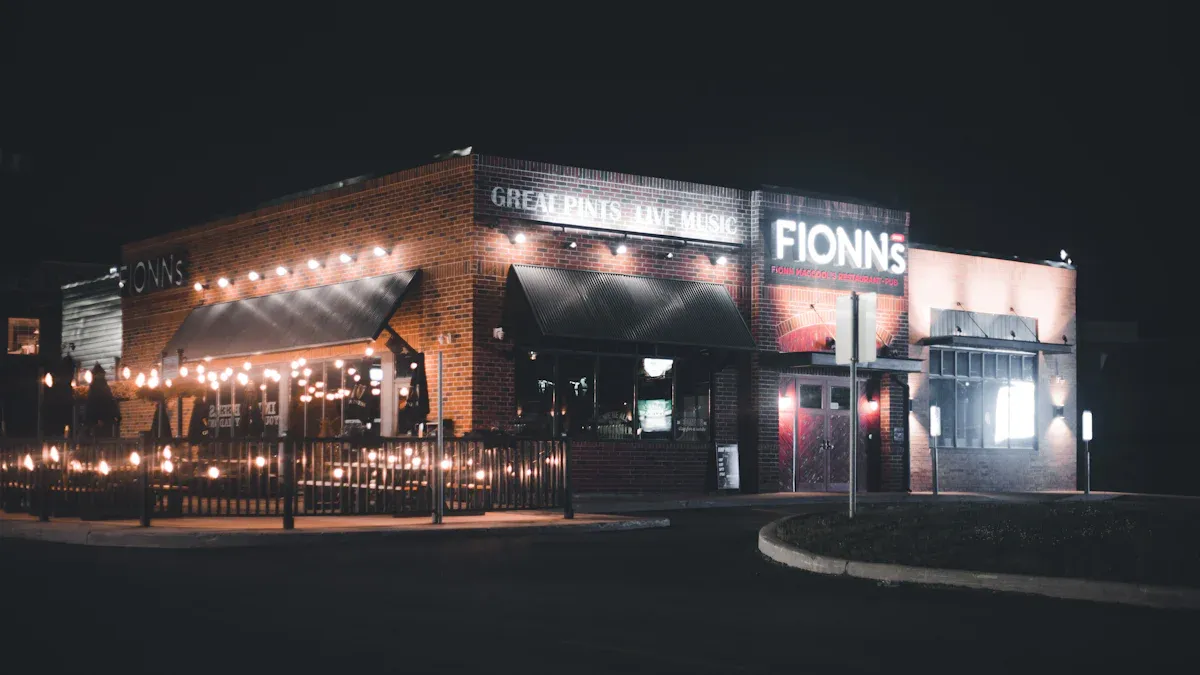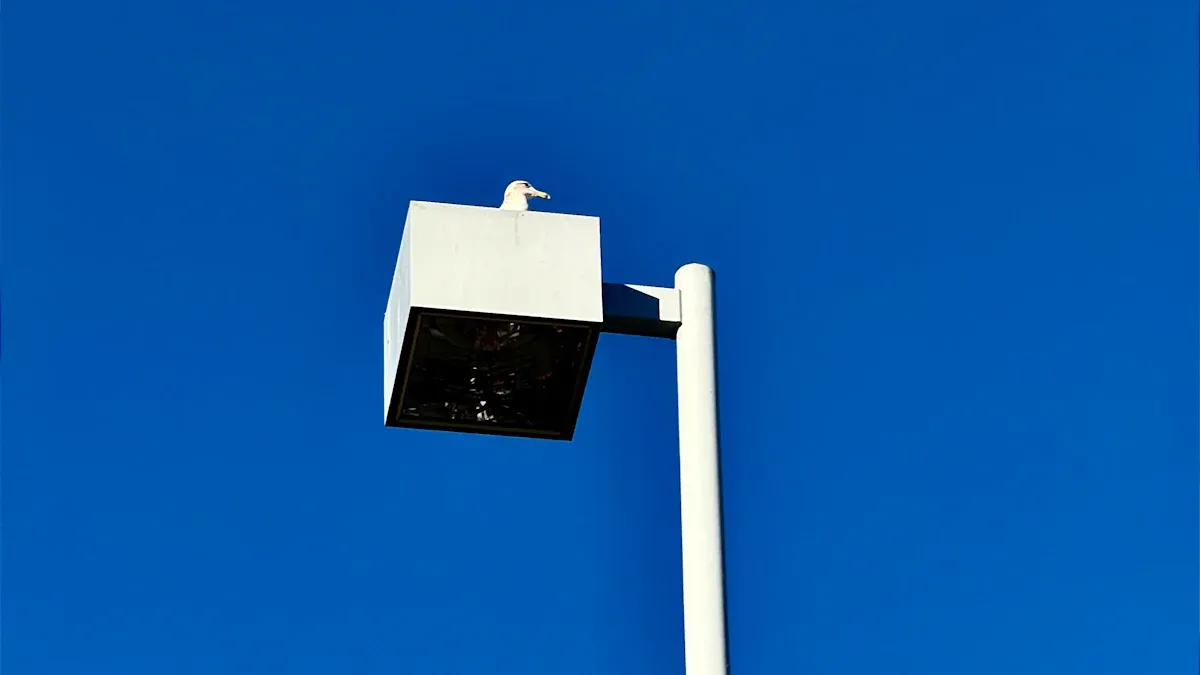How to Choose the Right Lighting for Your Business’s Outdoor Spaces

If you want to choose the right lighting for your home’s outdoor spaces, start by thinking about safety, security, and how people see your business. Good outdoor lighting helps keep your place safer at night.
Studies show that better lighting can lower nighttime crimes by 36 percent.
Cities like Newark have fewer violent crimes after using energy-saving LED streetlights.
Look at the table below to see how outdoor lighting affects how customers see your business and its image:
Evidence Type | Description |
|---|---|
Enhanced Visibility | Bright and colorful lights make the area lively. They help people notice your business and want to look closer. |
Perception of Safety | Well-lit places help customers feel safe. This can bring in new customers and make current ones feel better. |
Improved Mood and Comfort | Custom lighting makes the space feel nice. It helps customers stay longer and enjoy shopping more. |
Impulse Visits | Cool lighting can make people visit your business suddenly. This can help you get more sales and new customers. |
Positive Brand Association | Good lighting makes your business look trustworthy and easy to remember. |
Social Media Engagement | Special lighting displays make customers want to share pictures online. This helps more people see your business. |
Improved Navigation and Accessibility | Good lighting helps customers move around easily. It makes their visit better and more comfortable. |
You need lighting that fits your home and outdoor spaces. Whether you want people to feel welcome, learn about your business, or see your products clearly, the right lighting is important. About us, this guide will show you easy steps to pick the best lighting.
Key Takeaways
Good outdoor lighting helps keep people safe. It can lower crime by up to 36%. Lights in the right spots make dark places easy to see. This stops threats from hiding.
Bright lights make your business look better. More people will want to visit. Colorful lights make the place feel friendly. They also help people remember your brand.
LED lights use less energy and save money. You can cut costs by up to 75%. These lights last longer than others. They do not need much fixing, so you save more.
Look at your outdoor spaces closely. Think about what each area needs. Check how bright the lights should be. Make sure every spot is bright and feels nice.
Use smart controls for your outdoor lights. Automation helps save energy and money. You can control your lights easily and quickly.
Why Outdoor Lighting Matters

Safety & Security
You want everyone to feel safe at your business. Good outdoor lighting helps stop accidents. It makes walkways and parking lots easy to see. Bright lights in dark corners make it hard for criminals to hide. Studies show more streetlights can lower crime by 36%. Customers feel better about coming after dark.
Put security lights in the right spots for best coverage. Place lights high up so they shine over a big area. This helps make sure no dark corners are missed.
Here’s what good outdoor lights can do:
Show off landscaping
Make guests feel welcome
Keep trespassers away after hours
People avoid places that are not well lit. When you add more lights, customers and workers feel safer. They want to spend more time outside your business.
Curb Appeal & Branding
Outdoor lighting does more than keep people safe. It makes your business look nice and professional. Bright storefronts bring in more customers. For example, a bakery got 20% more walk-ins after adding themed lights. Good lighting at night can help people choose your business. Roofline lights make your business look better and bring more visitors after dark.
Outdoor lights help your signs stand out. When people see your business clearly, they remember it.
Factor | Description |
|---|---|
Enhanced Customer Experience | Better atmosphere and safety bring more customers. |
Increased Property Value | Makes your property worth more and easier to sell. |
Operational Benefits
Picking the right lights saves money and helps your business. New outdoor lights can cut energy costs by up to 75%. You spend less on fixing lights because new ones last longer, sometimes up to 100,000 hours.
The right outdoor lights make your property look and work better. They help people see your business and remember your brand.
Better lighting helps your business do well and keeps costs low. This is important for making more profit.
Using better lights helps the environment. These lights have lower emissions and no dangerous materials. Your business looks nicer, works better, and saves money.
Choose the Right Lighting for Your Needs
Assessing Outdoor Areas
Before you choose the right lighting, take a good look at your outdoor spaces. Every business has different needs, so you want to make sure your lighting plan fits your property. Walk around your building during the day and at night. Notice which areas look dark or unsafe. Think about where people walk, park, or gather.
Here are some key things to check when you assess your outdoor areas:
Purpose of Lighting: Decide if you need lights for safety, security, or just to make your place look nice.
Light Intensity and Coverage: Make sure the lights are bright enough and cover all the important spots. You do not want any dark corners.
Color Temperature: Pick a color that matches the mood you want. Warm lights feel cozy, while cool lights look bright and modern.
Placement and Spacing: Put lights where people need them most. Space them out so the whole area is lit up evenly.
Control Options: Use timers or motion sensors to save energy and make your lights work smarter.
Compliance with Local Regulations: Check the rules in your area so you do not get in trouble.
Light Distribution Patterns: Think about how the light spreads. Some areas need wide beams, while others need focused light.
Beam Angle Considerations: Use the right angle to avoid blinding people or wasting light.
Durability and Weather Resistance: Pick lights that can handle rain, snow, and wind.
Material Quality: Choose strong materials that last a long time.
Ingress Protection Rating: Look for ratings that show the lights can keep out water and dust.
Installation and Maintenance Considerations: Make sure you can install and take care of the lights easily.
Tip: Take notes or draw a simple map as you walk around. Mark the spots that need better lighting. This helps you plan and avoid missing any area.
Many businesses make mistakes by skipping this step. They might buy lights without a plan, pick the wrong fixtures, or leave parts of the property dark. Some even forget about maintenance or ignore local codes. When you take time to assess your space, you avoid these problems and make your business safer and more welcoming.
Defining Lighting Purpose
Once you know your outdoor areas, think about why you need lighting in each spot. Different zones need different types of lights. For example, the lights you use for your parking lot will not work for your entrance or sign.
Here’s a simple table to help you match lighting purpose to each area:
Purpose | Description |
|---|---|
Security Lighting | Bright, motion-activated lights in key areas such as entrances and parking lots enhance safety. |
Safety Lighting | Focus on illuminating pathways and stairways to prevent accidents. |
Aesthetic Lighting | Accent lights that highlight architectural features or landscape elements improve curb appeal. |
You want to choose the right lighting for each purpose. Security lighting keeps your property safe and helps people feel protected. Safety lighting makes sure no one trips or falls. Aesthetic lighting shows off your building and makes your business stand out.
Here are some things to remember:
Proper parking lot lighting helps customers feel safe.
If your business looks dark, people might not want to visit.
Good lighting makes your business look better and more inviting.
Different businesses have different needs. For example, industrial buildings need wide-beam lights for big open spaces and task lights for work areas. Retail stores often use bright lights to show off products and make customers feel welcome. Hotels and restaurants usually want warm, cozy lights to create a relaxing mood.
Note: Take time to plan your lighting goals before you buy anything. This helps you avoid common mistakes like blinding lights, dark spots, or picking the wrong fixtures. Always check that your plan follows local rules and uses the latest technology for the best results.
When you choose the right lighting for your needs, you make your business safer, more attractive, and easier to manage. You also save money and avoid headaches down the road.
Key Specs for Outdoor LED Fixtures
Brightness & Lumens
Brightness is very important for outdoor lights. You need enough light to see and stay safe. Too much light can feel uncomfortable. Lumens show how bright a bulb is. Small parking lots need bulbs with 12,000 to 18,000 lumens. Medium areas need 20,000 to 30,000 lumens. Big industrial spaces may need up to 70,000 lumens. Walkways and entrances can use less bright bulbs.
Here is a table with the best light levels:
Space Type | Suggested Horizontal Illumination (fc) | Suggested Vertical Illumination (fc) |
|---|---|---|
Parking lot | 3 fc | N/A |
Building entrances | 2 fc | N/A |
Egress paths | 0.1 fc | N/A |
Parking lots should have 50 to 100 lux. Loading areas need up to 200 lux. The right brightness helps people feel safe. It also makes your property easy to see.
Color Temperature
Color temperature changes how your outdoor area looks. Warm lighting feels cozy. Cool lighting helps with safety. Here are some choices:
2200K: Warm amber glow, good for small spaces.
2700K: Friendly and welcoming, nice for sitting outside.
3000K: Clear and bright, shows off nature.
4000K: Safe and useful, best for busy places.
Use warm tones if you want your business to feel friendly. Use cool tones for parking lots or paths. Cool tones help people see better and feel safe.
Tip: Mix warm and cool lights to make different zones. Warm lights work well for eating areas. Cool lights are good for entrances.
Durability & Weather Resistance
Outdoor lights must handle rain, dust, and wind. Pick fixtures that last a long time. High IP ratings mean better protection. IP65 or higher keeps out water and dust. IP44 protects against splashes. IP67 can handle short-term flooding. Aluminum and tempered glass make fixtures strong.
IP65: Good for rain and dust.
IP67: Handles tough weather and flooding.
Shock resistance: Best for busy places.
Quality Components
Good quality means lights last longer. Pick fixtures that work for up to 50,000 hours. A five-year warranty helps you worry less. LED lights need little care. Clean the lens and check for damage sometimes. Energy-saving models save money and help the earth. Nanotechnology in LEDs controls light and cuts waste.
Long life
Strong warranty
Easy care
Saves energy
The right lighting makes outdoor spaces safe and nice. You save money and help the planet too.
Fixture Types & Smart Controls

Parking Lot & Pathway Lights
You want your parking lots and walkways to be safe. Good lights help people see at night. Most businesses use outdoor area lights, flood lights, and wall packs. Area lights come in many wattages. You can pick the best one for your space. Flood lights spread light over big areas. This helps people see where to walk or drive. Wall packs go on building walls. They shine light down on walkways and parking spots.
Outdoor Area Lights: Work for small paths and big parking lots.
Flood Lights: Light up wide spaces so people see well.
Wall Packs: Brighten building edges and walkways nearby.
Parking lot lights are often on tall poles. They help drivers and walkers feel safe. Putting lights in good spots keeps things bright. The right fixture saves energy and makes your property look nice.
Wall & Perimeter Fixtures
Wall and perimeter lights do more than just make things bright. They help keep your building safe. These lights help people’s eyes adjust from dark to light. You want steady light with no dark spots or harsh shadows. This helps security cameras see clearly. People can spot anything strange more easily.
Even lighting around your building keeps trouble away. It helps everyone feel safe and comfortable.
Aspect | Recommendation |
|---|---|
Brightest to Darkest Ratio | Keep below 4:1 to stop shadows and risks |
Fixture Spacing | Should be 3-4 times the fixture’s height |
Vertical Illumination | Helps with threats from higher places |
If you space fixtures well and use the right brightness, your property is safer. People feel welcome and secure.
Smart Controls & Automation
Smart controls help you manage outdoor lights easily. You can use your phone or a hub to turn lights on or off. You can dim them or change their color. Many systems let you set times or use sensors. Lights can change when people move or when it gets dark. This saves energy and lowers costs.
Smart lighting systems can save up to 60% on bills.
Automation means you do not have to change lights by hand.
You get data to help you use energy better.
Benefit | Description |
|---|---|
Energy Savings | Save up to 60% energy with smart lighting. |
Operational Efficiency | Automation cuts manual work and helps you do more. |
Long-term Savings | Less fixing and longer-lasting lights save money. |
Smart controls let you make special effects, like color-changing lights for events. Your business space is safer, works better, and looks more fun.
Installation, Maintenance & Cost Savings
Installation Tips
When you put in outdoor lighting, you have two choices. You can do it yourself or hire a professional. Both ways have good and bad points. Look at this table to help you pick:
Consideration | DIY Approach | Professional Installation |
|---|---|---|
Safety | Needs wiring know-how to avoid hazards. | Meets safety codes and lowers risk of electrical problems. |
Design Expertise | May miss key design details. | Gives you a custom plan for your property and needs. |
Material Quality | Often uses lower-quality materials. | Uses high-grade materials for longer life. |
Cost | Lower upfront cost, but may cost more later. | Higher initial cost, better long-term investment. |
Time Commitment | Can take a lot of time and effort. | Saves you time with efficient work. |
Tip: If you want your lights to look great and work well, hiring a pro is usually the best choice.
Maintenance Best Practices
You want your lights to work for a long time. Taking care of them helps a lot. Clean your lights every few months so they stay bright. Check for water damage and fix broken parts fast. Here are some easy things to do:
Wipe off dust and dirt so the lights shine bright.
Cut back plants so they do not block the light.
Look for damage and rust often.
Make sure seals keep out water.
Change your care routine when seasons change.
Check seals and swap out any that look old.
Remove leaves and sticks, especially in the fall.
Look at all wires, especially in winter.
Note: A simple checklist helps you remember what to do and keeps your lights working well.
Rebates & Incentives
Switching to LED lights saves money and helps the earth. LED bulbs use much less energy than old bulbs. You can also get money back and tax breaks. Here is a quick guide:
Type of Incentive | Description |
|---|---|
Federal and Local Rebates | Helps pay for LED installation. |
Certifications Required | You need certifications like DLC or Energy Star to qualify. |
LEED Certification | LED lighting can help you earn LEED points for more rewards. |
179D Federal Tax Deduction | Lets you deduct costs for energy-saving lighting in commercial buildings. |
LED upgrades use less energy and lower your bills.
Smart controls and sensors save even more by turning lights on only when needed.
You can save up to $38,375 and 73,584 kWh each year.
Remember to ask your local power company about extra rebates. You could save more than you think!
You can make your business safer and more inviting with the right outdoor lighting. Start by setting clear goals, checking your current lights, and choosing fixtures that match your brand. Here’s a quick checklist to help you decide:
Define your lighting goals.
Check if areas are too dark or too bright.
Pick energy-saving LED fixtures.
Consult lighting experts for smart design.
Look for rebates to save money.
Investing in quality LED lighting boosts safety, cuts costs, and helps your business stand out.
FAQ
What type of outdoor lighting saves the most energy?
LED fixtures use less power than old bulbs. You get bright light and lower bills. Many businesses switch to LEDs for big savings. Look for Energy Star or DLC labels for the best results.
How often should you clean outdoor lights?
You should clean your outdoor lights every three months. Dust and dirt block light. Wipe the lens with a soft cloth. Check for water damage and fix problems fast.
Can smart controls work with any outdoor lights?
Most smart controls work with LED fixtures. You need compatible bulbs and a hub or app. Some older lights may not support automation. Ask your installer for advice.
Do you need permits for outdoor lighting upgrades?
You may need a permit for new wiring or big changes. Always check local rules before you start. Your installer can help with paperwork and inspections.
See Also
Selecting Ideal Outdoor Lighting Fixtures for Your Business Needs
Finding the Best LED Outdoor Lights for Your Residence
Tips for Selecting the Best Outdoor Lighting for Garages
Selecting Dependable Solar Lighting Solutions for Outdoor Spaces in 2025

